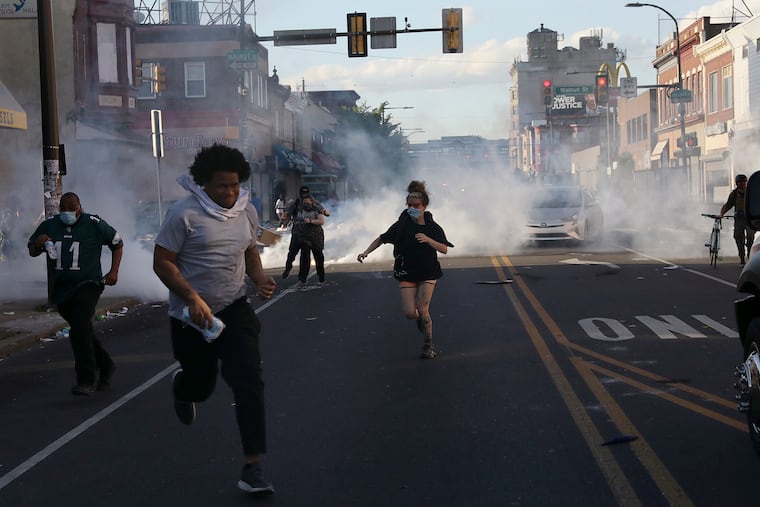Philly City Council votes to ban tear gas and rubber bullets in demonstrations
The legislation requires the Philadelphia Police Department to enact a policy protecting First Amendment activities from the use of those tactics.

Philadelphia City Council on Thursday approved a prohibition on the use of tear gas, rubber bullets, and pepper spray against demonstrators exercising their First Amendment rights.
The legislation passed, 14-3, after a heated debate about the meaning of peaceful assembly and disturbance, and the history of police brutality against Black people. Republican Councilmembers David Oh and Brian J. O’Neill, along with Democrat Bobby Henon, voted against it.
“This bill is a first step toward reaffirming that public protest is not at odds with public safety,” said Councilmember Helen Gym, its sponsor.
The virtual Council meeting grew tense when Oh suggested tear gas is appropriate for protesters who block traffic or refuse to disperse, even if it gets inside the homes of residents who are not involved.
“Better their homes have tear gas than be set on fire,” he said.
» READ MORE: ‘Shoot him,’ officer said before firing at Walter Wallace Jr., lawyer says bodycam footage shows
His colleagues rebuked him sharply, noting that the nation has a troubling history of authorities using violence against Black people peacefully standing up for their rights.
Gym introduced the bill after a Council committee heard this fall from residents attacked without warning by tear gas and rubber bullets in May and June during protests of the police killing of George Floyd in Minneapolis. That response "undid years of collaboration and work,” Gym said Thursday.
This week, there is renewed interest in the subject after two police officers fatally shot Walter Wallace Jr. outside his home in West Philadelphia, and as city officials prepare for potential demonstrations after Tuesday’s presidential election.
The legislation will now be sent to Mayor Jim Kenney. His administration supports the intent of the bill and will review it, spokesperson Mike Dunn said Thursday.
If Kenney signs it, the Police Department would write a policy defining what would be classified as protected actions.
The legislation is not an all-inclusive ban on the use of so-called less-than-lethal devices but would bar their use “on any individual engaging in First Amendment Activities.”
While Police Commissioner Danielle Outlaw ordered a moratorium in June on the use of tear gas to respond to protesters, some officers used pepper spray Tuesday night at 52nd and Market Streets as demonstrators gathered in response to Wallace’s killing.
Police used tear gas, rubber bullets, and pepper spray on 52nd Street in West Philadelphia on May 31 and on I-676 on June 1.
Kenney and Outlaw apologized in June for police gassing demonstrators on I-676 as they were trapped on the highway. In West Philadelphia, tear gas seeped into the homes of residents and families who were not involved in the demonstrations.
Some residents testified at Thursday’s Council meeting that the bill would limit police officers' ability to control violent situations.
Gym responded by noting that Philadelphia police have allowed protests for 20 years without deploying the tactics used in May and June — tear gas was last used on demonstrations in Philadelphia during the Republican National Convention in 2000.
» READ MORE: ‘I couldn’t breathe’: Inside the West Philly neighborhood teargassed by police
Councilmember Kenyatta Johnson — one of several members to rebut Oh — said his colleague’s comments were problematic.
“As Black people in particular, we have always been on the front lines protesting peacefully, and in times when we have decided to continue to take a stand we have been met with a very, very aggressive response from those who are monitoring the situation,” Johnson said. “I do take offense in terms of how I think you’re painting this lightly.”
Oh responded by suggesting that the civil rights movement and the George Floyd protests “obviously were very different circumstances" because civil rights leaders like the Rev. Dr. Martin Luther King Jr. had reasons to protest.
A police officer kneeling on Floyd’s neck for nearly nine minutes was a justifiable reason for protesting, Johnson shot back. Council President Darrell L. Clarke stepped in to ask the two men to stop interrupting each other and maintain decorum.
Others said Oh might not have been familiar with the experiences of residents impacted by the use of tear gas and rubber bullets in the spring.
“We heard dozens of families in terror, from little children to senior citizens not understanding why their government was moving against them," Councilmember Curtis Jones Jr. said. "And I know not only just the testimony, but people who felt threatened that just the only mistake they made was living in Southwest Philadelphia. They weren’t a part of the protest, but they were a part of the assault.”